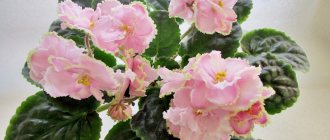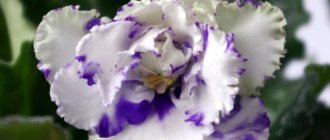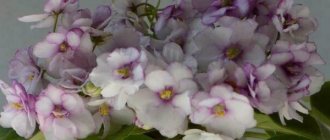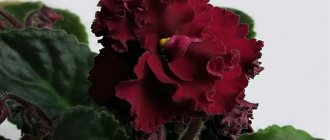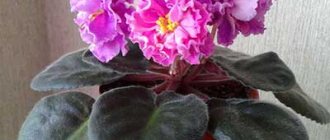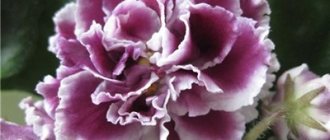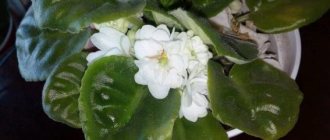This is due to the peculiarity of the color of the petals, in the center of which there is a pigmented stripe that differs from the main color.
Such stripes are less common on leaves. This species is on the list of the rarest and most expensive . His name is Chimera.
What flower is this called?
The Chimera owes its name to the ancient Greek mythical creature of the same name.
He was described as a goat with the head of a lion and the tail of a dragon, capable of spitting fire.
Centuries later, chimeras began to be called fictional animals, as well as fiction and fantasies, the existence of which is very difficult to believe.
The uniqueness of Chimera violets lies in the fact that they contain intertwined cells of different varieties. In this case, the cells of the varieties that make up the chimeras do not mix with each other and form layers. The bottom layer sets the color of the petal, the top layer - the stripe that lasts from its base to the tip.
There are the most diverse and bizarre combinations.
It turns out that one violet, like the ancient Chimera, consists of two or more components that belong to other violets . It's really hard to believe, but it's a fact.
Meaning of the word
Why some types of Saintpaulia are called “chimera violet” is now clear. What does this name actually mean?
The word "chimera" comes from Greek mythology. This was the name of a mythological monster with the head of a lion, the body of a goat and a dragon's tail. If biologists were to talk about this creature, they would emphasize that the organism consists of three groups of cellular tissue with different genetic characteristics. Agree that it is quite difficult to believe in the existence of such an organism, this became the reason for the appearance of a second meaning for the word. This is how they began to call bizarre fantasies that are difficult to believe. The chimera violet is the most bizarre fantasy created by man from natural material. This is probably why she is appreciated.
History of the species
During the process of violet domestication, an incomplete mutation occurred in the flower cells. Most of the cells received the characteristics of the mother plant, and a smaller part received the characteristics of another species. Since then, chimera violets have appeared in the process of reproduction.
Expert opinion
Pavlova Ekaterina Mikhailovna – agronomist, landscape designer
Participant of scientific conferences
Chimeric mutations still appear spontaneously. For example, the owner of a violet with pink petals, after rooting the cutting, may have a plant with purple stripes in the middle of the petals. Despite the efforts of scientists, it is impossible to obtain such mutations artificially in laboratory conditions. They arise by themselves.
The fact is that tissues of different cellular composition fit tightly to each other, but do not mix.
All that remains is to consolidate the emerging characteristics in a stable combination through selection . However, maintaining a stable color is not an easy and very painstaking task, since the mutation does not appear in every daughter plant.
What is Violet Fantasy?
Zlato Skifov.
Fantasy violets are plants with lush, bright flowering. Everyone who loves violets strives to get a collection of as many of these varieties as possible. You can get acquainted with different varieties of fantasy violets here - Types and varieties of Saintpaulia-Violets. As a rule, the leaves of such a plant are large and have a dark color, which creates a wonderful contrast with the bright shades of the inflorescences themselves, emphasizing their beauty and, as it were, drawing attention to them.
Every violet grower strives to get as many children as possible from such a bright plant, but most often such specimens produce sports that are no worse than the mother plant and never disappoint their owners. But if you want to get an exact copy of the mother violet from a fantasy violet, do not be disappointed immediately at the first try, but keep trying, it happens that from one cutting you get both sports and varietal children mixed together, and sometimes you can get all sports ones.
Views: 1,736
Photo
If you love such bright and spectacular Saintpaulias, we recommend that you also pay attention to the varieties “Dance of the Galaxy” and “Frosty Cherry”.
Stepsoning
Sometimes, with a high nitrogen content in the soil, you can observe the formation of small shoots in the axils of violet leaves. Since they often spoil the appearance, they are removed, but they can also be used for propagation.
After four leaves have formed on the stepson, cut it out of the mother’s rosette and place it in a substrate (sphagnum moss is suitable).
After the stepson takes root, it needs to be transplanted into a new container.
The entire process of reproduction by stepchildren takes at least several months. It is important to understand that it is better to cut out stepchildren even if you do not plan to reproduce.
Description and characteristics
You can distinguish a chimera from an ordinary violet by a stripe of contrasting color that runs from the center of the flower to the edge of the petal . The stripe can be either continuous or in the form of small strokes and spraying.
Chimeras have simple, semi-double and double flowers.
In this case, a fantasy pattern may appear on the petals . For example, on a white petal with a contrasting purple stripe along the edge there are mini strokes and dots of blue or purple shades.
Chimeras obtained from flowers with a green fringe along the edges can retain this feature.
There are flower chimeras and leaf chimeras. On leaf chimeras, the white stripe contrasts with the green base of the leaf. White color may also appear as streaks and dots of white or yellowish color.
Varieties of chimera violets with names and photos
You can find various varieties and sports of chimera violets on sale.
Olenka
Obtained from the chimeric variety PT-Svetlanka. Forms large semi-double flowers with a basic soft lilac tone, strewn with blue purple strokes, and a bright white line in the middle of the petals. The edge is outlined with a heavily ruffled pink border.
The leaves are round, quilted, light green, with a wavy edge. Standard.
Read more about Olenka violet in this article.
DS-Lavender Tale
Semi-miniature chimera. The flowers are simple star-shaped or semi-double light lavender in color with dark lavender chimeric stripes formed by small longitudinal fantasy strokes.
The leaves are bright green and lightly cover the top of the pot. The rosette is compact , maximum diameter is about 23 cm.
The flower opens with a dark color, gradually the background lightens and stripes appear. It blooms almost all the time , but does not form large bouquets; it forms several flower stalks at once.
The flowers are medium in size and bloom for a long time.
More information about the violet Lavender Tale is written here.
Yukako
The flowers are small, about 2-3 cm in diameter, star-shaped, do not open completely (half bell) . The petals are blue with a wavy edge and a greenish stripe runs down the middle. Over time, the color intensity weakens.
The leaves are large, curled downwards, medium green in color, with a wavy edge. Standard.
It blooms often and profusely , covering the entire rosette with a cap of flowers. Up to 35 buds can develop on a peduncle.
Attention! When breeding, it often produces sports.
Comprehensive information about the Yukako violet is given here.
DS-Pink
The flowers are bell-shaped, bright pink , the edges of the petals are wavy with blue chimeric stripes covered with small pink streaks. There is a white eye in the center of the flower.
The leaves are medium green, silvery on the reverse side, and have a smooth edge. The socket is dense and compact. Standard.
There are 1 to 3 large flowers on tall peduncles. Flowering is almost constant , the flowers last a long time.
Reproduces only by stepsons.
You can get more information about DS-Pink violet here.
AV-Leningradskoye Ice Cream
The flowers are huge, up to 7-8 cm in diameter , star-shaped, semi-double. The color of creamy ice cream with streaks of black currant color. A greenish-white border runs along the edge of the petals.
At the beginning of flowering, the buds are burgundy, the color changes gradually.
The leaves are medium green, the rosette is compact up to 18-23 cm in diameter. Standard.
Does not form clear chimeric stripes on the petals. It is classified as a chimera due to the fact that the color is not transmitted when propagated by cuttings. Parental characteristics are transmitted by stepsons and peduncles.
You can read more about violet AV-Leningrad ice cream in this article.
Order of Malta
Large simple stars , the edges of the petals are corrugated. The color of the flowers is burgundy-red with a white stripe.
The leaves are emerald green, slightly elongated. The socket is compact. Standard.
The flowers gradually increase in size , reaching 7 cm in diameter.
Peduncles are tall, flowering is long.
Important! Chimera violet of the Order of Malta reproduces by peduncles and stepsons.
Kilauea
Chimera violet Kilauea is a pink half-bell with a white stripe in the center of the petal , the edge of the petals is corrugated.
The leaves are pointed, glossy, quilted, light green in color. Standard.
Flower size is 4-5 cm . At moderate temperatures, the color of the flowers is paler.
Flowering lasts about 2 weeks , after which the flower falls off without wilting.
Calico queen
Translated, the chimera violet Calico Queen means Calico Queen.
The flowers are large, semi-double star-shaped with a pastel lavender color and wide purple stripes in the center of the petals. There is a narrow light border along the edge.
Violet Calico Queen has dark green foliage with wavy edges. Standard.
The flowers reach 4-4.5 cm , open in lilac color, which gradually acquires a chimeric color.
First bloom with ordinary flowers . The stripes appear gradually, during the second or third flowering.
OS-A Charm of Rus'
The flowers are large pale pink star-bells with a corrugated edge and blue linear stripes, the petals are generously strewn with blue fantasy touches. Sometimes the fantasy on the petals is large.
The foliage is green, serrated. Standard.
Flowering in a cap , strong, tall peduncles with 3-4 buds each. Chimera violet OS-A Charm of Russia blooms often and abundantly.
Ma's Bridal Bouquet
The flowers are large, voluminous, double , white in color, with a pink center. The edges of the petals have a greenish border.
The foliage is variegated, pointed, with a jagged edge. Standard.
Chimera violet Bridal Bouquet does not bloom often, but profusely . The variety is unpretentious and responsive. Gives pink sports.
Balchug Flight
Chimera violet Balchug Polet is a semi-miniature variety.
The flower is semi-double dark purple with a central white line. For a miniature rosette, the flowers are large, up to 3.5 cm in diameter . Numerous buds open within two weeks.
The leaves are glossy dark green. Standard.
At the first flowering there are many simple flowers, in subsequent blooms the number of semi-double ones increases. From 3 to 5 flowers bloom on erect peduncles. Flowering for 2-3 months.
Povitrulya
Large pink star-shaped flowers with a fuchsia color and white chimeric stripes. The leaves are bright green glossy, the edges are wavy. Standard.
Above you can see a photo of the chimera violet Povitrulya.
EK-7 Sky
Chimera violet 7 sky has very large semi-double flowers with a snow-white border along the edge, the color is soft blue, with a pronounced blue towards the center.
The central stripe is missing . Flowering is abundant, the flower cap covers the entire rosette.
The leaves are medium green, quilted, with a wavy edge. Standard.
Humako Monique (Monica)
Chimera violet Monica is an industrial variety . Simple pansies are white and cream in color with a wide blue stripe down the center of the petals.
The leaves are medium green, quilted, with a wavy edge. Standard.
Cap flowering for a long time. In the heat, the flowers lighten. Up to 10 flowers are formed on a peduncle.
The variety is unpretentious. Gives sports of different colors from pure white to white and blue.
Cathy's Fireworks
Cathy's Fireworks chimera violet is a semi-miniature variety. The flowers are simple, star-shaped, round, fuchsia in color with light pink lines in the center of the petals, up to 2 cm in diameter.
The leaves are variegated green and white, quilted, slightly curved downwards.
The flowers last for about a week, after which they fall off. Flowering is not spontaneous. 2-3 flowers bloom on a peduncle.
The variety is unpretentious. Forms a lot of stepsons.
The sport is fuchsia plain with a white border.
Psychedelic Show
The flowers are very large , up to 5 cm in diameter. The double pansy flowers are coral pink with fancy blue touches and a bright white central stripe.
The leaves are simple green. The rosette is about 20 cm, dense and neat.
As the flower blooms, the coral color becomes brighter. Continuous flowering . Clusters of buds form on the peduncle.
Psychedelic Show Chimera Violet is very stable.
Ness' Dream Maker
The flowers are simple and semi-double , the petals are white with a coral-pink central stripe and a white wavy border.
The leaves are small, medium green, and quilted.
Flowering is abundant and long lasting . Forms a cap of flowers. Flowering for more than a month , a short break.
Chimera violet Ness Dream Maker is an unpretentious variety . It transmits its characteristics well to offspring.
Often stepson, can produce pink sport.
Queen Sabrina
Semi-miniature variety . The flowers are star-shaped, large, double, coral-pink with a blue central stripe along the petals and lilac fantasy touches. The flowers reach 4 cm in diameter.
The leaves are dark green and slightly quilted. The rosette is compact, up to 15-17 cm in diameter, but can grow up to 23 cm.
Blooms profusely every month . The flowers form a hat. The peduncle bears 6-9 buds.
The chimera violet Queen Sabrina imparts its color when it spawns.
Emerald City
The flowers are cup-shaped , creamy white, with a light green stripe down the middle of the petal. On the reverse side the stripe is brighter and more contrasting.
The foliage is smooth, medium green, simple quilted. Rosette up to 25 cm in size.
The flowers are small, the blooms are friendly . When adopted, the Emerald City chimera violet does not always transmit the parent color.
Le Margarita
The flowers are simple, star-shaped , cup-shaped, the main tone is white with dark cherry color imprints in the center of the petals.
The diameter of the corolla is up to 6 cm, the flowers last quite a long time, although they are prone to falling off.
The leaves are dark green, with a wide white-variegated stripe along the edge.
Flowering is abundant , the cap is formed in the center of a neat rosette.
Chimera violet Margarita is an easy to grow variety. At the first flowering it forms small flowers, then they become larger.
AE-Ximera of Doom
The flowers are star-shaped , semi-double, the main color is white with blurred lilac central stripes.
The AE-Destiny Chimera Violet has simple quilted, medium green leaves with a slightly wavy edge.
A-Dream
Star-shaped, very large double flowers . The main tone of the petals is fuchsia-raspberry with a wide white central stripe.
Chimera violet A-Dream is distinguished by abundant flowering and a compact rosette.
Queen of beauty
Chimera Violet Beauty Queen is a chimera sport derived from the Reigning Beauty variety. The flowers are star-shaped, semi-double, the main color is purple-blue.
Along the edge of the petals there is a darker, sometimes greenish fringe that appears at moderate temperatures. A longitudinal clear light stripe runs through the center of the petals.
The foliage is simple, medium green in color with a wavy edge.
Psychedelic Moon
A chimeric sport obtained from the Psychedelic Show variety (you will also find a photo and description of the Psychedelic Show violet in this article).
The flowers are double stars, purple in color and have a white central stripe on the petals. The edge of the petals is wavy with a purple border.
The foliage is smooth and medium green. Chimera violet Psychedelic Moon forms a compact rosette.
Ness' Spring Blush
The flowers are star-shaped, simple or semi-double. The petals are bright white rounded with soft pink chimeric stripes and purple fantasies in the center.
The leaves are dark green, pointed, and often rise up. Semi-mini rosette up to 18 cm in diameter. Flowering is abundant.
Chimera violet Ness Spring Blush produces numerous stepsons, including many sports.
Victorian Parasol
The flowers are star-shaped, cup-shaped, semi-double with a fringe along the edge, the main tone is purple with a white line in the middle of the petals.
Violet-chimera Victorian Parasol blooms with a cap , forms up to 14 peduncles, each with 6-7 flowers. Flowering is abundant and lasts for a month and a half.
The violet Victorian Parasol is weakly pinched, so you have to cut off the top . Rooting of peduncles produces 100% chimeric offspring.
Lyon's Crown Jewel
The chimera violet Lyon'S Crown Jewel has a semi-double star-shaped flower of bright fuchsia color with a white central stripe on the petals.
The edge is dense, highly corrugated, edged with a greenish ruffle, which appears in cooler conditions.
Medium size flowers. Flowering is long lasting. The peduncle bears 4-5 flowers. When propagated by stepsons, chimera reproduces well.
If the foliage has darkened and turned red on the reverse side, then the plant will go into sport.
Rob's Kid Wheezy
Rob'S Kid Wheezy Chimera Violet is classified as a semi-miniature.
The flowers are very large , white, semi-double with a bright fuchsia color along the edges of the petals. The leaf is medium green, pointed.
Types of chimeras
Despite all the possible manifestations of different colors, chimeras are divided into 2 types based on the type of coloring: direct and reverse.
In chimera violets with a direct color type, the main color of the petal is lighter than the underlying stripe.
The reverse type is characterized by a petal color that is darker than the stripe.
There are also rarer, variegated varieties of chimeras.
They are characterized by chimeric coloring not only of the petals, but also of the leaves.
Indoor violet - description
Indoor violet is a herbaceous perennial plant. It has an underdeveloped fibrous root system and fleshy stems. Depending on the species, the stems can be short, with leaves growing at the roots and forming a rosette, or elongated, branching with a large number of hanging rosettes. The diameter of the stem can be from 6 to 60 centimeters long.
The leaves are round, elongated or ovate. The base is heart-shaped or simple. The tip is rounded or sharp. The edges are light, slightly rounded or coarsely serrated. The leaves are flat, highly corrugated, slightly wavy or curved in one direction or another.
The leaves are green in color, sometimes with silver or golden hues. Sometimes there are cream, olive, salad, yellow or pink areas on the leaves. Multi-colored areas are located along the edges of the sheet, at the base, or form a variety of patterns. The inner side of the leaf is most often silvery-green, sometimes has a red tint.
Rules of care
Chimera is a rather capricious plant. In order for it to bloom longer and at the same time maintain its unique color, you need to adhere to the following care rules:
Place
Western and eastern windows are considered the most suitable for chimera violets . This is where diffused sunlight penetrates in the right amount.
Exposure to direct sunlight, especially in summer, will destroy the unique color of the chimera violet and leave burns on the leaves.
Choosing a pot
The chimera will bloom only in a small pot, the diameter of which is three times smaller than the diameter of the rosette of leaves of the plant.
Maximum size 9x9. For young violets, sizes 5x5 and 7x7 are more suitable.
Important! In a ceramic pot, moisture evaporates faster due to micropores in the material .
Plastic pots help retain moisture inside.
Priming
The most suitable substrate for the growth of chimera violets is commercial violet soil , which contains the following elements in a balanced form - black soil, peat, coconut shavings, perlite.
Such soil is most conducive to moisture retention and oxygen penetration to the roots.
Temperature
Temperature. The most comfortable temperature indicator for chimeras is +22…+24°C.
This is interesting! When average daily temperatures fluctuate, the flowers will turn out faded. If the temperature exceeds the norm, the chimera will lose its unique coloring. The petals will become one color.
Chimeric coloration may appear again when suitable conditions are restored, but only during the next flowering.
These violets are especially sensitive to growing conditions and get sick more often than others. The following link will help you recognize the disease in time and prevent its development.
Watering
To avoid the appearance of diseases, it is necessary to water the chimera with purified water at a temperature of +20...+22°C. Cold water causes root rot.
The best way for chimeras is watering in trays.
The trays can be left full for no more than 15 minutes, making sure that the soil does not become waterlogged.
Usually watering is done 1-2 times a week.
Feeding
Chimeras do not need frequent feeding. One application of complex mineral fertilizer along with watering once a month will be enough. .
However, if the flowers have a limp appearance, you can increase the application of phosphorus and potassium fertilizers in accordance with the standards specified in the instructions.
Conditions for growing violets at home
As already mentioned, Saintpaulias and true violets have differences in their maintenance conditions. It is due to the fact that Saintpaulias come from hot countries, and therefore can grow only in a certain microclimate. It needs to be constantly supported.
Location and lighting
They should be placed on window sills on the east or west side. Since the flower should not be in direct sunlight, it must be shaded. If possible, you can build a shelving unit by placing it near the window. This way the flowers will receive enough light, but will not get burned.
Important! If the temperature is high, the contrast between the stripes will disappear, and the petals will gradually take on a uniform color. Everything can be returned during the next wave of flowering, but only if the temperature is within normal limits.
Temperature
The flower is heat-loving. All year round it needs to be maintained at a temperature of +22…+24°C, and there should be no nighttime fluctuations, as this will cause the color of the flowers to fade.
Air humidity
Humidity should be high. A container of water or wet pebbles should be placed near the pot. Water treatments should also be carried out regularly to wash away dust from the foliage. The main thing is to wipe each leaf from any remaining moisture after a shower.
Popular varieties
As a result of selection, most carefully carried out in the USA, a huge variety of chimera species appeared.
They are classified into industrial and collectible.
Often industrial types are not distinguished by super-original coloring and have less collection value.
At the same time, they have longer, abundant flowering.
Industrial and collection varieties are divided into classes:
- Standard
- Mini
- Semimini
- Suspended (ampel or trailer)
- Leafy
Mandy, Myrte, KRei, Robs Monkeyshines, Tineke, Victorian Parasol, Icy Hot - this is not a complete list of varieties of various shades popular abroad, on the basis of which domestic breeders began to develop their varieties.
The main difficulty in breeding chimera violets is that not all varieties are stable in preserving varietal characteristics. Therefore, the flower may look different after blooming.
Flower propagation methods and planting rules
Saintpaulias do not reproduce simply by leaves, like ordinary violets. Let's look at the most effective ways to propagate chimera flowers:
- The first method is based on the fact that the violet peduncle has a bract with a dormant bud, a stepson. Having carefully separated it, it is planted in a separate container with pre-disinfected soil for rooting. The main thing here is to create certain conditions for this by placing the sprout in a self-constructed box made from a bottle or film. This will help maintain a humid atmosphere inside. This method of propagation is not always effective, but there is no risk for the plant itself. In terms of duration, this method is also not suitable for everyone, especially those who are impatient in nature, because the transplanted peduncle will become an adult only after a year, and then it will bloom.
- Reproduction by cutting off the head of an adult plant is often used. The procedure is carried out below the growth point, capturing several rows of leaves. After six months, you can get another chimeric plant from the separated part. But trimming the top should be done on a sufficiently mature flower, in which several rows of leaves have already fully formed. A small number of stepsons will soon appear on the remaining stump, which also does not speak in favor of this method of propagation, although the flower stalks will grow quickly and produce new plants.
By destroying the growth point of the chimera, a person contributes to the rapid formation of stepchildren. But it will take a lot of time before you receive adult flowering Saintpaulias - about ten months. Once every two months it is necessary to remove the grown-up stepchildren, leaving only fragile babies on the mother's body.
When planting violet babies, you need to remember the size of the pot, which should not exceed much in diameter the rosette of the flower, but be at least 9 centimeters. The material for the container can be made of plastic and ceramics. It is necessary to lay a layer of drainage in the form of expanded clay and pieces of foam at the bottom, which will help the water not to stagnate in the pot.
The soil for the flower should be loose and nutritious.
If these planting rules are followed, the rooting of stepchildren will be successful. All methods of reproduction can increase the offspring of chimera violets, but for this you need to be patient.
Reproduction of such Saintpaulias
To preserve the mother color of the plant, the usual method of propagation by cuttings is not suitable in the case of chimera violets.
The following methods allow you to maintain the desired color:
- Reproduction using peduncles . At their base there is a dormant bud, from which, when carefully cut and rooted, a new shoot grows. He will eventually become a new violet.
- The upper part of the plant, along with flowers and one row of leaves, is completely cut off and planted in the ground . To avoid excessive evaporation of moisture, before roots appear, it is covered with film or glass containers to create greenhouse conditions.
- Rooting by stepchildren . To do this, the topmost shoot is cut off. After some time, lateral layers appear at the site of the break. These cuttings can be plucked and planted in the ground.
First difficulties
Official communities did not immediately agree that chimeras can be considered a separate variety of Saintpaulia. The American community of flower growers and violet lovers motivated their refusal by the fact that it is impossible to achieve the same color of plants by propagation by cuttings. It took a long time to prove that violet (Saintpaulia) produces flower and leaf chimeras using other methods of reproduction.
Today it has been proven that instability of reproduction can be overcome, and there are no problems with registering new varieties. However, the methods for obtaining such plants are very labor-intensive, which could not but affect the price of chimeras. So, in America, a baby chimera violet costs from 5 to 30 dollars.
How to form a bush correctly
The Chimera bush needs to be formed with age.
This is necessary so that the abundantly grown leaves do not compete with each other for sunlight, touch the ground less and do not destroy the decorative appearance of the plant.
Important! Frequent contact of chimera leaves with wet soil can be a stimulus for the development of diseases such as late blight and gray rot.
It is also necessary to remove overgrown lateral layers of leaves - stepsons.
They can cause flowering to stop, as they take up nutrients coming from the roots.
Ideally, the green mass should be arranged in three rows.
The lower row, the basis of which is usually old leaves, can be completely removed if the remaining rows are well developed.
It is necessary to remove dried and diseased (if any) leaves and faded buds to preserve the overall decorative appearance of the plant.
Chimera is a variety whose maintenance requires considerable effort from the grower.
However, with proper care, timely replanting and compliance with the rules of propagation and selection, this flower will adorn the breeder’s collection for a long time.
In the next article we will talk about caring for another spectacular violet of the “Raisin” variety.
Possible difficulties during cultivation
The Chimera is sensitive to diseases and pests, such as:
- Thrips. Insects destroy flower anthers and roots. They need to be controlled with insecticides.
- Root rot. The plant begins to wither. It is urgent to replant the plant, and if the roots are completely damaged, then cut off the top and root.
- Fusarium. Covers the foliage with a brown coating, and the leaves begin to rot. It urgently needs to be replanted in new soil.
Did you know? Saintpaulia was discovered and approved as a separate genus in 1893, and already in 1949 there were 100 species of these plants.
For preventive purposes you should:
- disinfect the soil before planting with potassium permanganate or freezing;
- follow all care instructions.
Violet Chimera is a flower of extraordinary beauty. This wonderful creation of nature needs special care and close attention. For this it will thank you with unique flowering.
